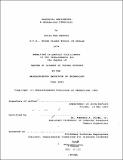Graphical marionette : a modern-day Pinocchio
Author(s)
Maxwell, Delle Rae
DownloadFull printable version (6.732Mb)
Other Contributors
Massachusetts Institute of Technology. Dept. of Architecture.
Advisor
Kenneth R. Sloan, Jr.
Terms of use
Metadata
Show full item recordAbstract
Representing the form and movement of human beings naturally, expressively, and computationally is a challenging endeavor. While the skeletal framework can be conveniently described, conventional modeling techniques are generally inadequate for rendering the flexible and irregular surface features of the body. Detail that is sacrificed in articulating the geometry of a life-like character can be compensated for by realistically depicting the character's motion. It is theorized that the most effective method of capturing the subtle dynamics of human motion is to track that motion directly. With the goal of complete body-tracking in view, a prototype system for designing "graphical marionettes" animated by diverse inputs has been developed. The evolution of body modeling as both an artistic and scientific concern are reviewed as precedents to current modeling systems. The development of data structures, animation programs, and some singular rendering techniques are discussed within the context of the project. several difficulties in handling missing or occluded motion data are presented. Some interesting animation scenarios are envisioned as future applications of the system. Improvements to the present version - are suggested in the concluding chapter.
Description
Thesis (M.S.V.S.)--Massachusetts Institute of Technology, Dept. of Architecture, 1983. MICROFICHE COPY AVAILABLE IN ARCHIVES AND ROTCH Includes bibliographical references (leaves 104-108).
Date issued
1983Department
Massachusetts Institute of Technology. Department of ArchitecturePublisher
Massachusetts Institute of Technology
Keywords
Architecture.